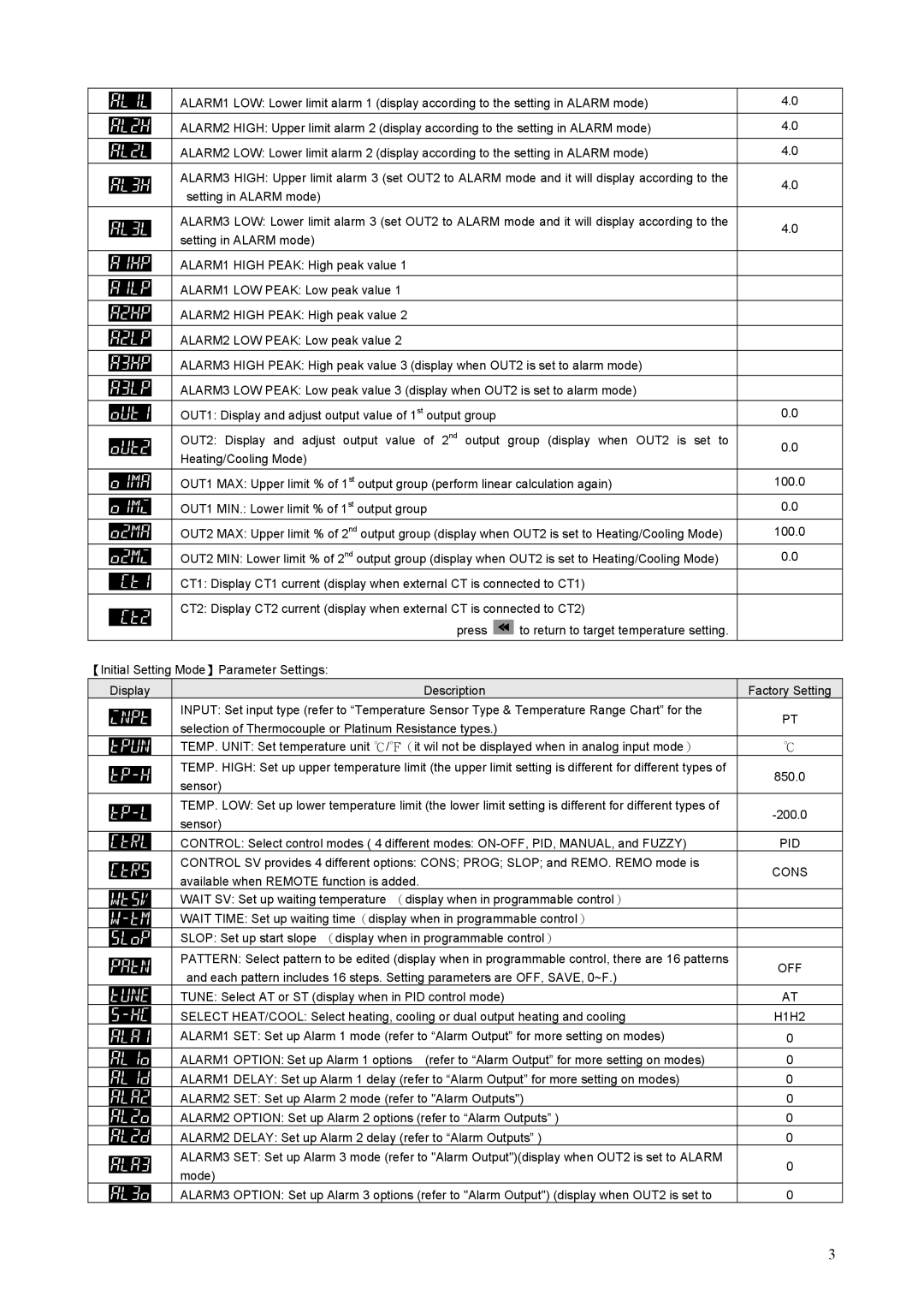
| ALARM1 LOW: Lower limit alarm 1 (display according to the setting in ALARM mode) | 4.0 | ||
| ALARM2 HIGH: Upper limit alarm 2 (display according to the setting in ALARM mode) | 4.0 | ||
|
|
| ||
| ALARM2 LOW: Lower limit alarm 2 (display according to the setting in ALARM mode) | 4.0 | ||
| ALARM3 HIGH: Upper limit alarm 3 (set OUT2 to ALARM mode and it will display according to the | 4.0 | ||
| setting in ALARM mode) |
|
| |
|
|
|
| |
|
|
| ||
| ALARM3 LOW: Lower limit alarm 3 (set OUT2 to ALARM mode and it will display according to the | 4.0 | ||
| setting in ALARM mode) |
|
| |
|
|
|
| |
| ALARM1 HIGH PEAK: High peak value 1 |
|
|
|
|
|
|
|
|
| ALARM1 LOW PEAK: Low peak value 1 |
|
|
|
| ALARM2 HIGH PEAK: High peak value 2 |
|
|
|
|
|
|
|
|
| ALARM2 LOW PEAK: Low peak value 2 |
|
|
|
| ALARM3 HIGH PEAK: High peak value 3 (display when OUT2 is set to alarm mode) |
| ||
|
|
| ||
| ALARM3 LOW PEAK: Low peak value 3 (display when OUT2 is set to alarm mode) |
| ||
| OUT1: Display and adjust output value of 1st output group |
| 0.0 | |
| OUT2: Display and adjust output value | of 2nd output | group (display when OUT2 is set to | 0.0 |
| Heating/Cooling Mode) |
|
| |
|
|
|
| |
| OUT1 MAX: Upper limit % of 1st output group (perform linear calculation again) | 100.0 | ||
| OUT1 MIN.: Lower limit % of 1st output group |
| 0.0 | |
| OUT2 MAX: Upper limit % of 2nd output group (display when OUT2 is set to Heating/Cooling Mode) | 100.0 | ||
| OUT2 MIN: Lower limit % of 2nd output group (display when OUT2 is set to Heating/Cooling Mode) | 0.0 | ||
| CT1: Display CT1 current (display when external CT is connected to CT1) |
| ||
| CT2: Display CT2 current (display when external CT is connected to CT2) |
| ||
|
| press | to return to target temperature setting. |
|
【Initial Setting Mode】Parameter Settings: |
|
|
| |
Display |
| Description |
| Factory Setting |
| INPUT: Set input type (refer to “Temperature Sensor Type & Temperature Range Chart” for the | PT | ||
| selection of Thermocouple or Platinum Resistance types.) |
| ||
|
|
| ||
| TEMP. UNIT: Set temperature unit ℃/℉(it wil not be displayed when in analog input mode) | ℃ | ||
| TEMP. HIGH: Set up upper temperature limit (the upper limit setting is different for different types of | 850.0 | ||
| sensor) |
|
| |
|
|
|
| |
| TEMP. LOW: Set up lower temperature limit (the lower limit setting is different for different types of | |||
| sensor) |
|
| |
|
|
|
| |
| CONTROL: Select control modes ( 4 different modes: | PID | ||
| CONTROL SV provides 4 different options: CONS; PROG; SLOP; and REMO. REMO mode is | CONS | ||
| available when REMOTE function is added. |
|
| |
|
|
|
| |
| WAIT SV: Set up waiting temperature (display when in programmable control) |
| ||
| WAIT TIME: Set up waiting time(display when in programmable control) |
| ||
| SLOP: Set up start slope (display when in programmable control) |
| ||
| PATTERN: Select pattern to be edited (display when in programmable control, there are 16 patterns | OFF | ||
| and each pattern includes 16 steps. Setting parameters are OFF, SAVE, 0~F.) | |||
|
| |||
| TUNE: Select AT or ST (display when in PID control mode) |
| AT | |
| SELECT HEAT/COOL: Select heating, cooling or dual output heating and cooling | H1H2 | ||
| ALARM1 SET: Set up Alarm 1 mode (refer to “Alarm Output” for more setting on modes) | 0 | ||
| ALARM1 OPTION: Set up Alarm 1 options | (refer to “Alarm Output” for more setting on modes) | 0 | |
| ALARM1 DELAY: Set up Alarm 1 delay (refer to “Alarm Output” for more setting on modes) | 0 | ||
| ALARM2 SET: Set up Alarm 2 mode (refer to "Alarm Outputs") | 0 | ||
| ALARM2 OPTION: Set up Alarm 2 options (refer to “Alarm Outputs” ) | 0 | ||
| ALARM2 DELAY: Set up Alarm 2 delay (refer to “Alarm Outputs” ) | 0 | ||
| ALARM3 SET: Set up Alarm 3 mode (refer to "Alarm Output")(display when OUT2 is set to ALARM | 0 | ||
| mode) |
|
| |
|
|
|
| |
| ALARM3 OPTION: Set up Alarm 3 options (refer to "Alarm Output") (display when OUT2 is set to | 0 | ||
3
